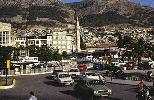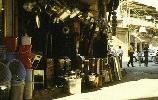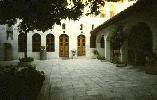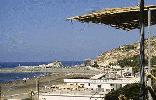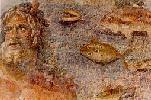| Hatay... |
|
Hatay or Antakya, the biblical Antioch, is situated on the Asi River (Orontes) in a fertile surrounding. Antakya was once
the capital of the Seleucid kings and the life they lead in Antakya was renowned for its luxury and pleasures during Roman
times. The city was the center of Christianity and had been visited by St.Barnabas, St.Paul and St.Peter. The city was also
famous as a center of artistic, scientific and commercial activities. The Hatay Museum deserves a particular interest,in
that it houses one of the richest collections of Roman mosaics in the world. A little outside the city is the holy site
where St.Peter's Grotto is situated. The cave church is the place where St.Peter preached and founded the Christian
community. It was declared as a holy place by Vatican in 1983. The Iron Gate of Antioch is to the south of the grotto among
the ruins of the city. One can sense these far off times since little has changed since that time. The Castle of Antioch
will give you a panoramic view over. Antakya is steeped in history and mythology at every step Harbiye, 8 km after Antioch,
is the place where Apollo fell in love with Daphne and tried to have her, but Mother Earth, in order to save Daphne, turned
her into an elegant tree. The site is full of these trees accompanying the orchid gardens, and waterfalls where you may have
a pleasant meal. St. Pierre Church, Haron Carving are the main historical remains. For both beach and sightseeing opportunities
Samandag is perfect. Seleuica Pieria, 6 km south of Samandag, is the ancient city which was a busy port at the time when Paul
and Barnabas made their first missionary journey from here. The Titus - Vespasianus Tunnel which was built to divert the
rain waters, even by today's standard, is a superb example of engineering. Near by there are 12 rock tombs to be visited.
A drive to Kapisuyu village will provide you with a fascinating scene from the Zeus Temple. There is an excellent view from
there of the harbor, sandy beach and fertile plain lying below. There are many picnic and camping areas. Hunting, fishing
and thermal springs' facilities are the other attractions. Iron is mined and Hatay is a transportation link with Syria and
other parts of Türkiye. The population is predominantly Arab but includes many Christians. The sanjak of Alexandretta was
awarded to Syria in 1920 and in 1936 became the subject of a complaint to the League of Nations by Türkiye, which claimed
that the privileges of the Turkish minority in the sanjak were being infringed.
|
|
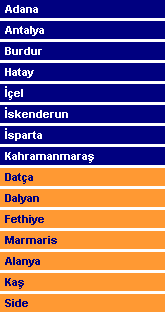
|


